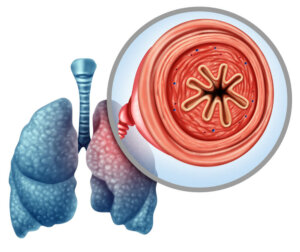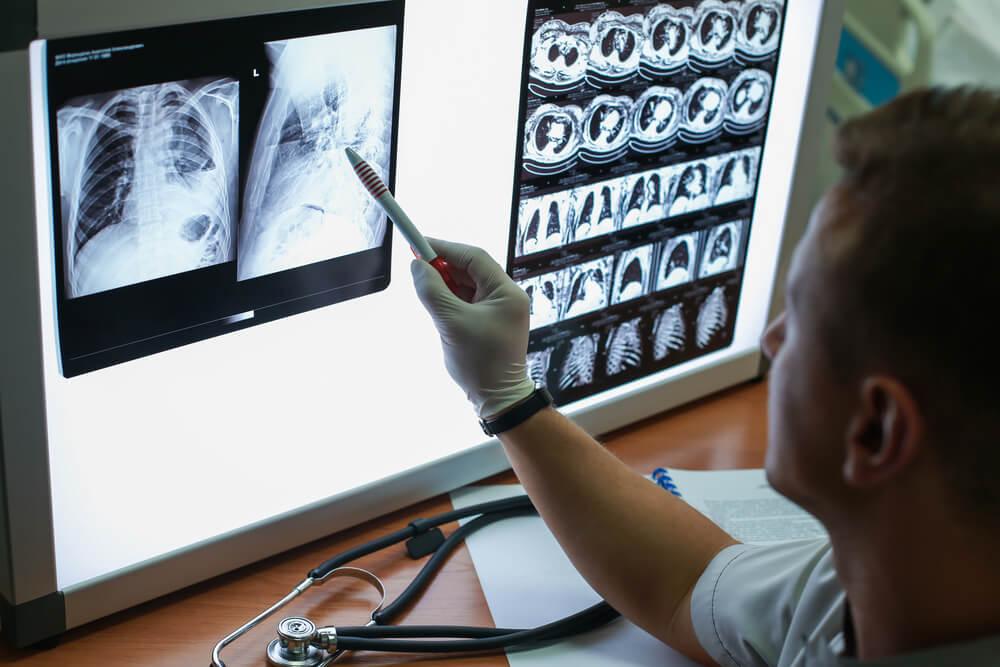The Main Causes of COPD

COPD or chronic obstructive pulmonary disease is a progressive disease that causes difficulty in breathing properly. The fact that it is progressive means that the pathology worsens as time passes.
Despite there being different triggers, the main cause of COPD is tobacco smoking. Most of the people who suffer from this disease either smoke now or used to. However, up to 25% of people with COPD never smoked. This data indicates that there are also other triggering causes.
Long-term exposure to other lung irritants, such as polluted air, chemical fumes, or dust, can also contribute to COPD.
General information about COPD
To understand COPD, it’s important to understand how the lungs work. In this sense, the air we breathe goes down the windpipe into tubes that go to the lungs. These are the bronchial tubes or airways.
Inside the lungs, the bronchial tubes branch many times into thousands of smaller tubes known as bronchioles. In turn, these structures continue to branch into clusters of tiny rounded air sacs called alveoli.

When the inhaled air reaches these alveoli, the oxygen passes through the walls of these into the blood of the capillaries that surround them. At the same time, the carbon dioxide that comes from the cells passes from the capillaries to the alveoli.
This process is known in science as gas exchange and, as we have seen, its objective is to bring oxygen to the body in order to perform vital functions and eliminate carbon dioxide, which is a waste product.
In COPD, the amount of air that moves in and out of the airways decreases. Some reasons behind this are that:
- The bronchi and alveoli lose elasticity
- The walls that separate many of the alveoli are destroyed
- The bronchial tubes produce a lot of mucus and can become clogged
- The walls of the bronchi become thickened and inflamed
You may be interested in: 7 Keys to Producing More Dopamine
Main causes
In the vast majority of cases, lung damage caused by COPD is caused by smoking over a long period of time. However, there are also other factors that play an important role in the development of COPD. This is the case with genetics.

Around 20-30% of smokers could have the disease.
On the other hand, in developing countries, this disease occurs in people who are exposed to combustible gases used for cooking or heating in houses with poor ventilation.
Causes of airway obstruction include the following:
- Emphysema: This is a disease of the lungs that destroys the fragile walls and elastic fibers of the alveoli. The small airways collapse when you exhale, preventing the flow of air out of the lungs.
- Chronic bronchitis: In this case, the bronchial tubes become inflamed and narrow, and the lungs produce more mucus. In this way, the bronchi narrow more, and the degree of blockage increases.
Α-1 antitrypsin deficiency
In approximately 1% of patients, the disease is caused by a genetic disorder that causes low levels of a protein called α-1 antitrypsin.
This protein is produced in the liver. It’s secreted into the bloodstream in order to protect the lungs. Therefore, a deficiency of α-1 antitrypsin can affect the liver as well as the lungs.
Damage to the organs of the respiratory system can occur in infants and children as well as in adults.
For adults with COPD related to this protein, treatment options are the same as for people with COPD triggered by other causes. Also, treatment for some people may be to replace the missing α-1 antitrypsin protein. This measure could prevent further damage.
Discover more here: The 5 Most Common Allergies in Children
Prevention measures

Unlike other diseases, COPD has an expensive cause and a means of prevention. Since most cases are related to tobacco, the best form of prevention is to quit this harmful habit.
On the other hand, the exposure to chemical fumes and dust are other risk factors for this respiratory disease. So, if you work with these types of irritants, talk to your supervisor about the best ways to protect yourself.
COPD or chronic obstructive pulmonary disease is a progressive disease that causes difficulty in breathing properly. The fact that it is progressive means that the pathology worsens as time passes.
Despite there being different triggers, the main cause of COPD is tobacco smoking. Most of the people who suffer from this disease either smoke now or used to. However, up to 25% of people with COPD never smoked. This data indicates that there are also other triggering causes.
Long-term exposure to other lung irritants, such as polluted air, chemical fumes, or dust, can also contribute to COPD.
General information about COPD
To understand COPD, it’s important to understand how the lungs work. In this sense, the air we breathe goes down the windpipe into tubes that go to the lungs. These are the bronchial tubes or airways.
Inside the lungs, the bronchial tubes branch many times into thousands of smaller tubes known as bronchioles. In turn, these structures continue to branch into clusters of tiny rounded air sacs called alveoli.

When the inhaled air reaches these alveoli, the oxygen passes through the walls of these into the blood of the capillaries that surround them. At the same time, the carbon dioxide that comes from the cells passes from the capillaries to the alveoli.
This process is known in science as gas exchange and, as we have seen, its objective is to bring oxygen to the body in order to perform vital functions and eliminate carbon dioxide, which is a waste product.
In COPD, the amount of air that moves in and out of the airways decreases. Some reasons behind this are that:
- The bronchi and alveoli lose elasticity
- The walls that separate many of the alveoli are destroyed
- The bronchial tubes produce a lot of mucus and can become clogged
- The walls of the bronchi become thickened and inflamed
You may be interested in: 7 Keys to Producing More Dopamine
Main causes
In the vast majority of cases, lung damage caused by COPD is caused by smoking over a long period of time. However, there are also other factors that play an important role in the development of COPD. This is the case with genetics.

Around 20-30% of smokers could have the disease.
On the other hand, in developing countries, this disease occurs in people who are exposed to combustible gases used for cooking or heating in houses with poor ventilation.
Causes of airway obstruction include the following:
- Emphysema: This is a disease of the lungs that destroys the fragile walls and elastic fibers of the alveoli. The small airways collapse when you exhale, preventing the flow of air out of the lungs.
- Chronic bronchitis: In this case, the bronchial tubes become inflamed and narrow, and the lungs produce more mucus. In this way, the bronchi narrow more, and the degree of blockage increases.
Α-1 antitrypsin deficiency
In approximately 1% of patients, the disease is caused by a genetic disorder that causes low levels of a protein called α-1 antitrypsin.
This protein is produced in the liver. It’s secreted into the bloodstream in order to protect the lungs. Therefore, a deficiency of α-1 antitrypsin can affect the liver as well as the lungs.
Damage to the organs of the respiratory system can occur in infants and children as well as in adults.
For adults with COPD related to this protein, treatment options are the same as for people with COPD triggered by other causes. Also, treatment for some people may be to replace the missing α-1 antitrypsin protein. This measure could prevent further damage.
Discover more here: The 5 Most Common Allergies in Children
Prevention measures

Unlike other diseases, COPD has an expensive cause and a means of prevention. Since most cases are related to tobacco, the best form of prevention is to quit this harmful habit.
On the other hand, the exposure to chemical fumes and dust are other risk factors for this respiratory disease. So, if you work with these types of irritants, talk to your supervisor about the best ways to protect yourself.
- González Torralba, F. (2015). EPOC. Revista de Patologia Respiratoria. https://doi.org/10.1017/CBO9781107415324.004
- Brown, J. P., & Martinez, C. H. (2016). Chronic obstructive pulmonary disease comorbidities. Current Opinion in Pulmonary Medicine. https://doi.org/10.1097/MCP.0000000000000241
- Batres, S. A., León, J. V., & Álvarez-Sala, R. (2007). EPOC y estado nutricional. Archivos de Bronconeumologia. https://doi.org/10.1157/13101956
- Miravitlles, M., Soler-Cataluña, J. J., Calle, M., Molina, J., Almagro, P., Quintano, J. A., … Ancochea, J. (2017). Guía española de la EPOC (GesEPOC) 2017. Tratamiento farmacológico de la EPOC estable. Archivos de Bronconeumologia. https://doi.org/10.1016/j.arbr.2017.03.017
Este texto se ofrece únicamente con propósitos informativos y no reemplaza la consulta con un profesional. Ante dudas, consulta a tu especialista.







